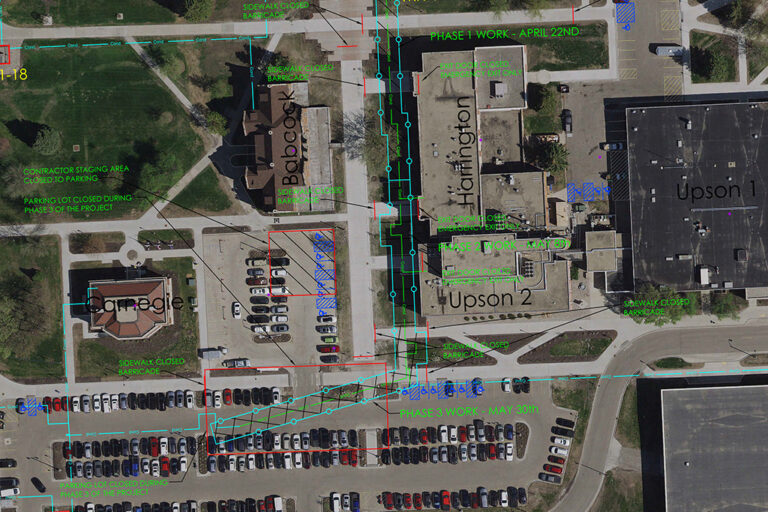The Higher Learning Commission’s upcoming visit: What to know

UND has been continuously accredited by the Higher Learning Commission since 1913, and the University now is engaged in reaffirming that accreditation — a process that universities must undergo every 10 years. (HLC accredits colleges and universities in a 19-state region and is one of seven accrediting agencies in the United States.)
UND already has completed a comprehensive evaluation to document how fully the University is meeting the five criteria established by the HLC. Now, another key component of the reaffirmation process is fast approaching: the visit to campus on April 22-23 by the Higher Learning Commission’s reviewing team.
In anticipation of that visit, the University’s Office of Institutional Effectiveness & Accreditation has developed a webpage, Prepare for HLC Visit. The webpage explains the importance of accreditation for UND, gives background on the reaffirmation process and tells members of the campus community what to expect when the HLC reviewers arrive.
The Higher Learning Commission (HLC) Reaffirmation is extremely important to the future of UND because accreditation ensures quality courses, administration and resources. Learn how to be prepared for the upcoming HLC visit.
About HLC Visit
UND will be assessed on five criteria including: our mission, integrity, teaching, learning and institutional effectiveness.
The peer review site team is made up of five individuals from other universities, including a team chair. The team chair creates a visit agenda, usually a month before their visit.
The site visit agenda often includes meetings with members of the governing board, faculty and staff, student representatives, and alumni or community leaders. These will be scheduled ahead of time.
The HLC team also enjoys interacting informally with members of the University while on campus.
Students, faculty and staff are encouraged to participate in aspects of the reaffirmation process, including attending open forums during the site visit. The open forum times are still being determined.
Following its site visit, the team will prepare a report with its recommendation for action by an HLC decision-making body.
Criteria
UND will be assessed on five criteria, as evidenced through UND’s Assurance Argument, which was submitted to the HLC in March.
The criteria are the standards by which HLC determines whether UND merits reaffirmation of accreditation. Below are key points for each criterion to help members of the University community prepare for conversations with the HLC site visit team.
Criterion 1: Mission
The institution’s mission is clear and articulated publicly; it guides the institution’s operations.
• UND’s mission is: “To provide exceptional educational experiences that enrich the lives of North Dakotans and the global community through excellence in teaching, innovative research, and meaningful engagement.” It is articulated publicly, operationalized throughout the institution and demonstrates our commitment to the citizens of North Dakota.
• UND launched its new UND LEADS (Learning, Equity, Affinity, Discovery, Service) Strategic Plan in January 2023, demonstrating our educational role is to serve our students.
• The UND LEADS Strategic Plan impacts UND’s work by recognizing the importance of enhancing student success by fostering cross-cultural interaction, improving retention and completion rates, and enhancing learning and understanding in the academic realm.
Criterion 2: Integrity — Ethical and Responsible Conduct
The institution acts with integrity; its conduct is ethical and responsible.
• UND adheres to more than 150 North Dakota State Board of Higher Education policies and all applicable federal policies directly related to the responsible acquisition, discovery and application of knowledge by our faculty, staff and students.
• UND is committed to best practices, in policy and in implementation, related to academic and research honesty and integrity.
Criterion 3: Teaching and Learning — Quality, Resources and Support
The institution provides quality education, wherever and however its offerings are delivered.
• UND employs approximately 2,800 staff members, including more than 700 full-time instructional faculty, and hundreds of part-time staff members serving in both administrative and instructional roles. UND has a 17-to-1 student to instructional faculty ratio.
• Our dedicated faculty and staff members provide services and instruction to our students, conduct original research, and serve the Grand Forks community as well as the State of North Dakota — ensuring that UND provides our students with effective, high-quality educational programs and services.
• UND provides student support services and support for student learning. Examples of this student support are numerous, and include: UNIV 101 courses, academic advising, the Recruitment/Retention of American Indians into Nursing program, the International Center, Veteran & Military Services, the University Counseling Center, the Wellness Center, One-Stop Student Services, Career Services, TRIO Programs, New Student Orientation, the Writing Center, and the Math Active Learning Lab (MALL) to name just a few.
• UND assures that our academic instructors are current in their disciplines, adept in their teaching roles and supports their professional development through the Teaching Transformation & Development Academy (TTaDA).
• TTaDA provides a wide array of services for faculty, graduate teaching assistants and staff, including training related to diversity and inclusion, book group discussions, both live and recorded training sessions, tutorials, assistance with course design for all delivery methods, and learning and development experiences.
• TTaDA’s programming also focuses on supporting the UND community as we navigate contemporary pedagogical issues in higher education, such as educating the UND community about the ethical use of generative artificial intelligence.
Criterion 4: Teaching and Learning — Evaluation and Improvement
The institution demonstrates responsibility for the quality of its educational programs, learning environments, and support services, and it evaluates their effectiveness for student learning through processes designed to promote continuous improvement.
• UND conducts ongoing assessment of student learning as part of our commitment to our students’ educational outcomes. A major part of this process includes annual assessment reporting, including assessment of student learning and achievement of learning goals in both academic and cocurricular programs.
• UND engages in a systematic program review process, known as Academic Program Review (APR). This process occurs over a five-year cycle for all UND programs, including both graduate and undergraduate programs. The APR process demonstrates our commitment to the quality and continuous improvement of our educational programs and student success, as well as provides insight into how curriculum, scholarly activity and service advance the University’s mission to serve the state and global community.
• UND strives to improve retention, persistence and completion rates across all our degree and certificate programs. UND accomplishes this by providing services such as academic advising and tutoring, career services, writing assistance, and assistance with library research for our students — whether they are on campus or online.
Criterion 5: Institutional Effectiveness, Resources and Planning
The institution’s resources, structures, and processes are sufficient to fulfill its mission, improve the quality of its educational offerings, and respond to future challenges and opportunities.
• UND allocates appropriate resources to align with our mission and priorities and has a robust resource base that supports our educational offerings and plans for maintaining and strengthening their quality in the future.
• This is evidenced by the support from the State of North Dakota (more than $100M annually), our Moody’s bond rating (A1 and Aa3), and the fiscally responsible Model for Incentive-Based Resource Allocation (MIRA) budget model.

